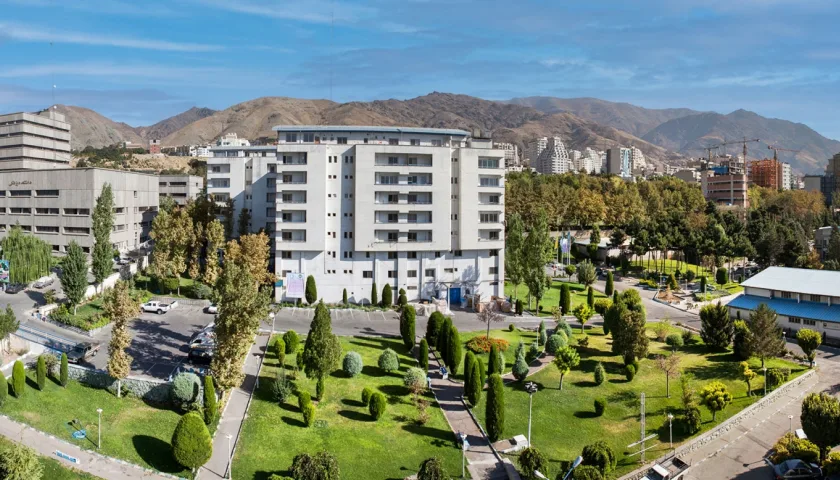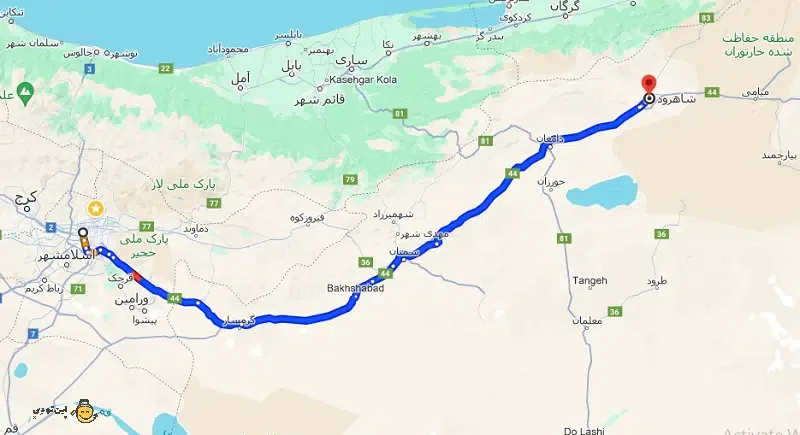Kebab Bonab (Sautori Kebab) Recipe: A Delicious Iranian Specialty
Kebab Bonab (Sautori Kebab) Recipe: A Delicious Iranian Specialty
Kebab Bonab is one of the most delicious types of Iranian kebabs, originating from the city of Bonab in East Azerbaijan. This kebab, which has been served on Iranian tables for hospitality since ancient times, bears a strong resemblance to Kubideh kebab. To prepare Kebab Bonab, you’ll need lamb meat, onions, salt, and pepper.
One notable difference between Kubideh and Bonab kebabs is that in preparing Kebab Bonab, the meat is minced along with finely chopped onions, giving it a “sautori” texture. In contrast, Kubideh meat is minced two or three times and then mixed with grated onions. Additionally, Kebab Bonab is much larger in size than regular Kubideh, with a wider shape, and it contains much less onion. As a result, Kebab Bonab is firmer than typical Kubideh. Furthermore, unlike Kubideh, Kebab Bonab never uses lamb tail fat, as it would make the kebab soft and give it an undesirable smell. The best fat for this kebab comes from the lamb’s own kidney fat.
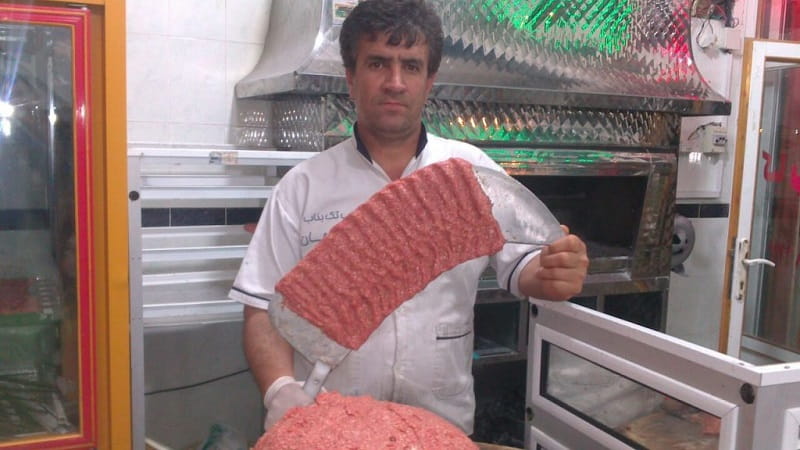
In the past, large cleavers were used to finely chop the meat, making the process laborious. For this reason, Kebab Bonab is also known as “Sautori Kebab.” Nowadays, the kebab is prepared using a meat grinder instead of cleavers. The weight of a Kebab Bonab ranges from a regular 100 grams to a special 250 grams, and it is often seen on skewers measuring 60 centimeters to one meter in kebab shops. Kebab Bonab is typically served with hot sangak bread or rice, accompanied by a cup of doogh (yogurt drink) or cold soda.
Now, let’s go through the steps of preparing Kebab Bonab
Ingredients for Four Servings (Four 60-centimeter Skewers):
- – 400 grams lamb fillet (coarsely ground once)
- – 600 grams veal sirloin (coarsely ground once)
- – 50 grams butter
- – Saffron infusion (as needed)
- – 4 medium-sized onions, peeled and finely chopped
- – Salt, red pepper, and black pepper (to taste)
- – Finely chopped parsley (optional)
- – Rice or bread, Kebab tomatoes, butter, thick yogurt, raw onions, and herbs for serving
Instructions
Step 1:
Place the coarsely ground lamb fillet and veal sirloin in a bowl along with the finely chopped onions. Ensure that the onions for Kebab Bonab are not too finely chopped or grated. The onions should be chopped in a way that they don’t release too much water and appear coarse under the teeth. Mix the onions, meat, and, if desired, some finely chopped parsley for about 10 minutes until well combined. Use a knife to strike the meat and onions to achieve a sautori texture.
Add 1 teaspoon of black pepper, 1 teaspoon of red pepper, and 1 teaspoon of salt to the kebab mixture. Mix well with your hands. Cover the bowl with plastic wrap and let the kebab mixture rest in the refrigerator for 1 to 2 hours.
Step 2:
After 1 hour, take the kebab mixture out of the refrigerator and knead it for a few more minutes.
Step 3:
Skewering the Kebab: Wet your hands and separate about 250 grams of meat. Mold the kebab mixture into a cylindrical shape with your hands and thread it onto a skewer. Spread the kebab evenly along the skewer. After preparing each skewer, place them on a tray so that the meat does not come into contact with the surface.
Repeat the process for the remaining skewers.
Now, your Kebab Bonab is ready to be grilled or cooked according to your preference. Serve it with rice or bread, Kebab tomatoes, butter, thick yogurt, raw onions, and herbs. Enjoy this authentic Iranian delicacy with family and friends!
Step 4:
Place your grill or kebab cooker at the highest possible heat and place the kebab skewers over the flame. At this stage, quickly rotate the kebabs every 10 seconds to absorb heat and prevent the raw meat from sticking to the skewer. Ensure that the heat is consistent, and if the flame is too low, your kebabs may fall off the skewer. Use a bellows to fan the flames for even heating.
After two minutes, the meat turns golden brown. In this stage, slowly flip the skewers every few minutes to ensure the meat is no longer raw and cooks through.
Step 5:
While the meat is cooking, melt some butter in a dish and microwave it for a few seconds until it turns into a liquid. If desired, add a bit of saffron infusion to the butter. Brush this sauce onto the kebabs using a brush to make them flavorful and moist.
Step 6:
Separate the kebabs from the skewers using bread and sprinkle a little sumac on top. Serve Kebab Bonab with rice or bread, kebab tomatoes, butter, thick yogurt, raw onions, and herbs, especially basil.

Kebab Bonab Recipe Tips:
– To finely chop the onions, it’s helpful to use a cleaver. Remember that the onions should be chopped in a way that they’re not too finely minced or grated, maintaining a coarse texture.
– You can start by chopping the onions into small cubes. Then, place the chopped onions on a cutting board and use a cleaver to make horizontal and vertical cuts, making the onions finer.
– A small amount of finely chopped parsley should be added to Kebab Bonab, just enough not to change its color.
– In preparing Kebab Bonab, black and red pepper are essential. Black pepper adds a good aroma, and red pepper gives it spiciness.
– Adding saffron to Kebab Bonab is optional and can be omitted from the required ingredients.
– The preparation of Kebab Bonab Tabriz follows the exact same steps as traditional Kebab Bonab.
– For Kebab Bonab with greens, add one cup of chopped parsley and three chopped green onions to the kebab mixture.
Now, you have a detailed guide to preparing Kebab Bonab, a delicious Iranian specialty. Enjoy your meal!”
“Tips for Skewering and Grilling Kebab Bonab:
– Use stainless steel skewers for making Kebab Bonab.
– Another method for skewering Kebab Bonab is to cut two green peppers into finger-sized pieces. Skewer the meat as mentioned above, but create evenly spaced slots on the meat using your thumb and forefinger. Place the green peppers between the slots to enhance the flavor of the kebab.
– One of the reasons for kebabs falling off the skewer is uneven or low charcoal heat. Ensure that the charcoal is well-lit and provides consistent heat to prevent the meat from falling off.
– Use wide and suitable skewers for skewering Kebab Bonab. Thin skewers may cause the kebab to fall off.
– Avoid using excessive and intense heat when grilling the meat. In the first three to four minutes, rotate the kebabs several times and use a front-to-back and back-to-front motion for fanning to ensure even cooking.
History of Kebab Bonab:
Kebab Bonab, with its global reputation, is one of the most delicious Iranian kebabs, dating back to the Qajar period. The modern method of preparing Kebab Bonab has been around for about a hundred years and was invented by the late Samad Ashpazbashi in Bonab. Kebab Bonab, a royal dish during the Qajar era, is considered the best brand of Iranian kebabs and was registered as an intangible cultural heritage of Iran in 1394 (Solar Hijri).
Bonab, located in East Azerbaijan, is known as the city of kebabs, and perhaps the first image that comes to mind for any tourist is the abundance of kebab shops and butcher shops ready to serve customers in every corner of the city. Bonab has over 200 kebab shops, and the number of its fast-food outlets is beyond count.
The cooking tradition of modern Kebab Bonab can be attributed to the names Samad Ashpazbashi and Ousa Mehdi. Samad Ashpazbashi had a shop in the “Ouzon Bazaar,” and the fame of Kebab Bonab started from his shop. Ousa Mehdi, known as Mehdi Safikhani, mentioned in an interview with Mehr News Agency:
The history of cooking the new type of Kebab Bonab dates back a hundred years, and Samad Ashpazbashi was its founder
Many factors contribute to the popularity of Kebab Bonab, such as the type of meat, the use of finely chopped onions, the grilling method, and the existence of caravanserais in the past that served as resting places for travelers.
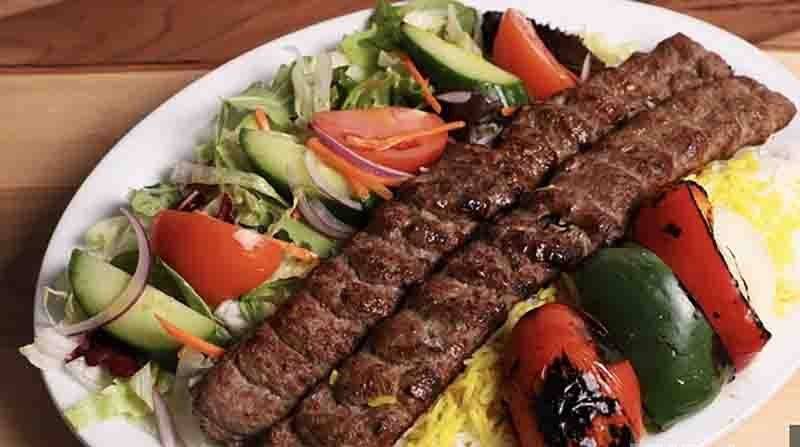
Traditional Kebab Bonab:
For the traditional preparation of Kebab Bonab by Samad Ashpazbashi, boneless lamb or veal meat was finely chopped by strong and young apprentices using a cleaver on a wooden chopping board. Interestingly, walnut kernels were used for pounding because they were very firm and did not break during pounding. Contrary to other kebabs, no sweet milk was added to the pounded meat. Instead, a small amount of chopped mint and tarragon leaves were used during pounding. The chopped meat was then left for 15 to 20 minutes to absorb the flavors.
The onions used in Kebab Bonab were traditionally placed on the chopped walnut and squeezed to drain excess water, preventing the kebab from turning black. Samad Ashpazbashi experimentally used about 150 grams of finely chopped onions per kilogram of chopped meat, and a small amount of salt was applied to the kebab mixture before grilling for meat firmness. During the cooking process, after the kebab was half-cooked and the fat was released, it was removed from the fire and placed between two pieces of bread to absorb the excess fat. Then, the kebab was placed back on the fire. This process not only ensured the cooked marrow of the Kebab Bonab but also prevented it from burning.
Samad Ashpazbashi had another method to enhance the taste of the kebab. He mixed local melted butter with the yolks and whites of eggs, and after the kebab was half-cooked, he soaked it in this sauce before putting it back on the charcoal. This additional step made the kebab more tender and flavorful. According to Mehdi Safikhani, the style of Samad Ashpazbashi’s cooking is different from the current method, and the kebabs back then were more spindle-shaped, somewhat round, and heavily seasoned. Additionally, the skewers at that time were short and wide, about 13 centimeters in width.
Samad Ashpazbashi molded the kebab into a spindle shape and grilled it with fragrant herbs, pepper, and spices. This type of kebab weighed around 400 grams of meat and was sufficient for two people. Unlike other kebabs, the meat of Kebab Bonab in the past was not flattened or pounded on a smooth stone during skewering; instead, it was skillfully prepared and ready for cooking during skewering.
In the past, Samad Ashpazbashi made kebabs in the shape of spindles and cooked them with aromatic herbs, peppers, and spices. This kind of kebab weighed around 400 grams and was enough for two people. The meat of Kebab Bonab was skillfully prepared and ready for cooking during skewering without being flattened or pounded on a smooth stone.
Now, the tradition of making Kebab Bonab is continued by the descendants of those skilled chefs, carrying the legacy of a century-old culinary art. Kebab Bonab is not just a meal; it is a symbol of cultural heritage, skill, and a taste that has stood the test of time.”
Mehdi Safi Khani continued:
“The fame of Kebab Bonab lies in its unique cooking style, where the meat is marinated with aromatic herbs in egg yolk. Depending on the customer’s preference, they would cook kebabs with veal or chicken meat, and all the cooking stages were done manually (with a bellows) over wood charcoal, adding to its enjoyment. This is in contrast to today, where all the stages have become mechanized.
Although Kebab Bonab has undergone changes in its cooking method, it still differs significantly from kebabs cooked in other cities under the name Kebab Bonab.
Walnut and grape tree charcoal (moo) are not suitable for grilling kebabs because the small charcoal pieces scatter and stick to parts of the kebab during grilling, altering its taste. That’s why wood charcoal was used in those times. Mehdi Safi Khani further explained:
“Samad Ashpazbashi worked in Tehran and Karaj during his youth, and often diplomats, ministers, and government officials were his customers.”
The affluent class and the aristocracy were the customers of Samad Ashpazbashi, and his kebab cooking witnessed the daily presence of the government officials of that era. However, during those times, when meat was expensive and the ordinary class of society could consume such food less regularly, the kebab business was more of a daily routine for the government officials of that era.
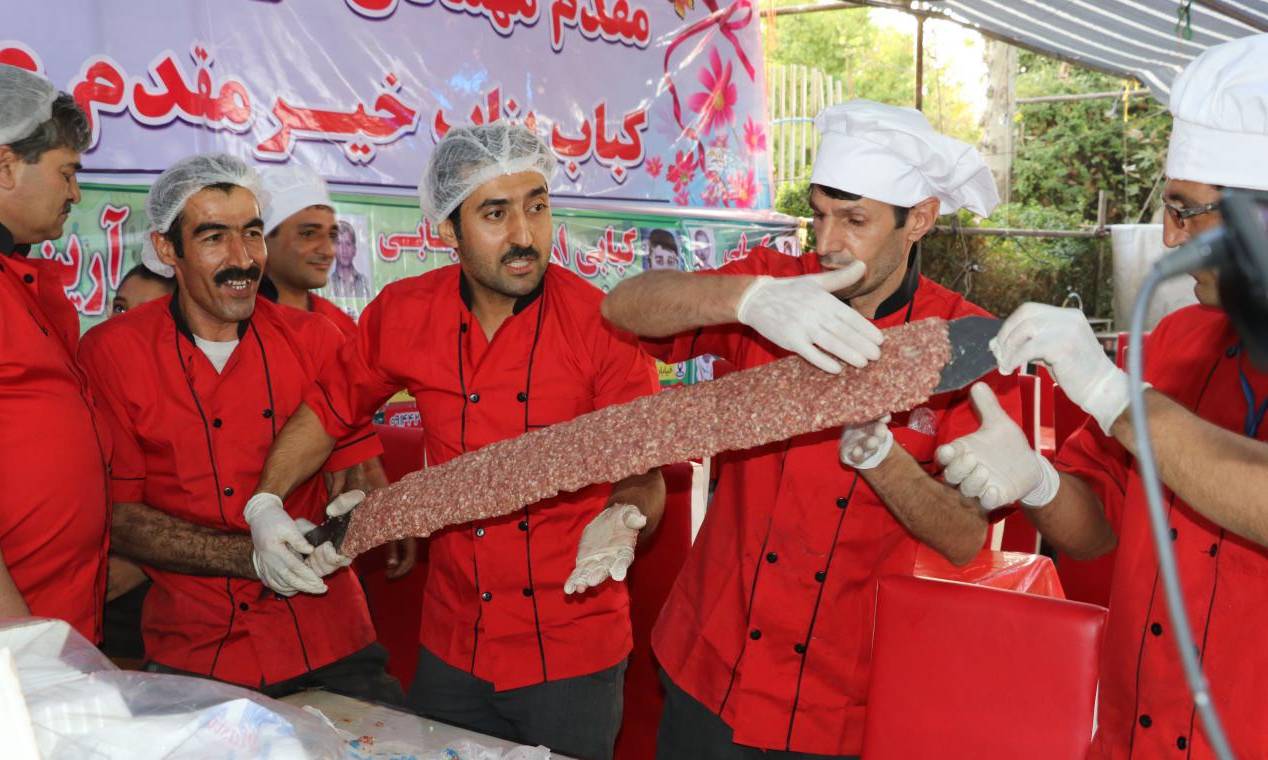
Kebab Bonab with Tomato Kebab
As Mehdi Safi Khani pointed out, Kebab Bonab is no longer cooked in the unique style of Samad Ashpazbashi in Bonab, and it is likely due to changes in people’s taste preferences. He continued:
“Customers no longer prefer kebabs that are heavily spiced or made with eggs, and they are unfamiliar with kebabs made with chicken meat. Therefore, to ensure their satisfaction, we cook kebabs in the style that is more widely accepted. However, if a customer is familiar with and orders the traditional style, we also cook it for them in the traditional way.”
According to Safi Khani, Kebab Bonab still preserves some of its unique characteristics, such as being large and wide or the way it is marinated. Therefore, it differs from kebabs in other cities.
“In the past, kebab cooks would ensure the quality of kebab meat by purchasing it from a trusted butcher nearby, or customers themselves would procure the meat from their trusted butcher and bring it to the kebab cooks. The reason for the high number of butchers in this city is for this reason, and even today, this tradition is preserved. Many customers still buy the meat themselves and bring it to the kebab cooks.”
National Kebab Bonab Festival
After the registration of Kebab Bonab in the intangible cultural heritage of Iran in 1394 (Solar Hijri), the first National Kebab Bonab Festival in this city was held in the summer of 1394. The aim was to introduce this food more as a national cultural heritage and to attract tourists, promoting this city as a new destination. Farzin Haghpas, the director-general of cultural heritage, handicrafts, and tourism of East Azerbaijan, said:
“The presence of high-quality meat and raw materials due to the special and pristine climate of Bonab, the traditional and unique cooking method of this food, as well as the significant employment of the local people in this work, have set Kebab Bonab apart from other cooked kebabs in the country.”
It’s interesting to note that in the second edition of this festival in 1395, more than 55,000 people attended, and 25,000 portions of food were sold. Forty percent of the participants in this festival were non-locals, and the remaining 60 percent were residents of Bonab. In just three days of the festival, over 3.5 tons of meat were consumed at the booths in the venue. The last and fifth edition of the National Kebab Bonab Festival was held in the summer of 1398.
The Taste of Kebab Bonab
How to Prepare Kebab in Different Cities of Iran
During your journey to East Azerbaijan, be sure to visit the city of Bonab, southwest of Tabriz, the city of kebabs, and treat yourself to the authentic taste of Kebab Bonab. Savoring a skewer of genuine Kebab Bonab with its rich, tender texture and an infinitely delightful flavor, accompanied by traditional sangak bread and a glass of fresh local yogurt, is one of the pleasures that you should by no means miss. The city of Bonab is the birthplace of this special and unique Iranian kebab, and its kebabs are counted among the tourist attractions of the city.
To experience the taste of Kebab Bonab, it’s not necessary to travel to Bonab itself. You can simply try your hand at making this kebab at home on a leisure day, creating a memorable experience for yourself and your family. Kebab Bonab can be served with fresh bread or saffron-infused rice, along with butter, fresh herbs, and kebab-style tomatoes.






